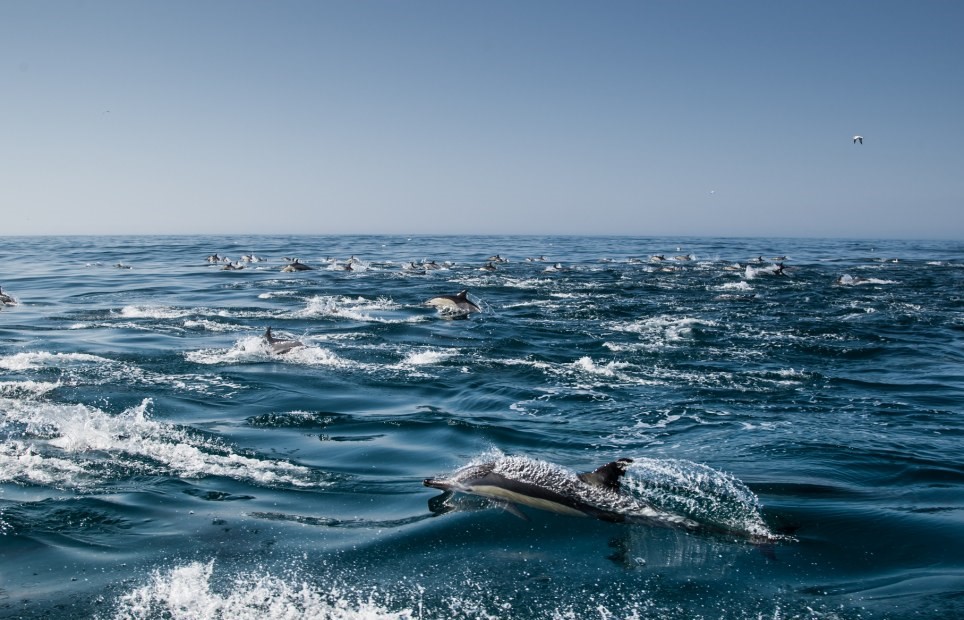
Do Dolphins Hibernate or Migrate? Researchers have found that dolphins do not follow definitive migration patterns, but they are known to move seasonally.
Hello readers, I hope you are well. In this exploration, we will investigate the intricacies of dolphins’ winter behavior, focusing on whether they hibernate or migrate during the colder months.
We’ll unravel the mysteries surrounding these marine mammals’ habits, discussing “do dolphins hibernate or migrate”, how they adapt to survive in colder waters, and exploring the intriguing patterns of their sleep.
Table of Contents
Why Dolphins Don’t Hibernate
Dolphins’ Breathing Mechanism
Unlike most marine animals, dolphins are mammals, and like humans, they rely on lungs for breathing. This fundamental distinction renders hibernation an impossibility for dolphins.
Their need to resurface every 15 to 30 minutes to breathe, a stark contrast to the respiratory systems of fish, underscores the incompatibility of hibernation with their biology.
Adaptations for Cold Waters
Dolphins have evolved ingenious adaptations to navigate cold waters without the need for hibernation. Chief among these adaptations is their thick layer of blubber, serving as a natural insulation layer.
This blubber not only provides warmth but also functions as a vital energy source during periods of food scarcity. [Do Dolphins Hibernate or Migrate?]
Additionally, dolphins can slow down their metabolic rate, allowing them to survive without regular food intake, a crucial departure from the hibernation strategy.
Social Behavior
Dolphins, renowned for their complex social bonds, engage in intricate communication through clicks, whistles, and body language.
The social nature of dolphins stands as another reason why hibernation is not in their behavioral repertoire. [Do Dolphins Hibernate or Migrate?]
The interruption caused by hibernation would likely disrupt their social dynamics, potentially harming relationships and established hierarchies.

How Dolphins Sleep
Unihemispheric Slow-Wave Sleep
Dolphins possess a fascinating sleep pattern known as unihemispheric slow-wave sleep. This unique phenomenon involves shutting down only one hemisphere of the brain at a time while keeping the other half active and alert.
This allows dolphins to rest and perform essential tasks like muscle relaxation and tissue repair while maintaining vigilance against potential threats.
Sleep Patterns and Duration
Contrary to human deep sleep, dolphins opt for short bursts of rest throughout the day. They may either rest motionless at the water’s surface or swim slowly, always with one eye open to remain aware of their surroundings.
The need for consciousness during sleep serves as a protective measure against drowning, emphasizing the constant adaptation required for survival in the marine environment.
In the subsequent sections of this exploration, we will delve deeper into the extraordinary abilities of dolphins, including their impressive breath-holding capacity and migration patterns.
As we unravel the mysteries of these captivating marine mammals, a clearer picture emerges of how they navigate the challenges presented by winter. [Do Dolphins Hibernate or Migrate?]
Dolphins’ Ability to Hold Breath
Dolphin Lung Capacity and Adaptations
One of the most remarkable features of dolphins is their ability to hold their breath underwater. Dolphins can stay submerged for up to 20 minutes, although the typical duration is around 10 minutes.
This exceptional capability is attributed to their high lung capacity, enabling them to store a significant amount of oxygen before diving. [Do Dolphins Hibernate or Migrate?]
Dolphins have evolved specialized adaptations, such as the ability to slow down their heart rate and redirect blood flow to vital organs, allowing them to optimize oxygen usage and extend their time underwater.
Factors Influencing Breath-Holding Duration
Several factors influence how long dolphins can hold their breath. Age, sex, and the depth of the dive all play crucial roles.
Younger dolphins generally have shorter breath-holding capacities compared to adults. Additionally, male dolphins, with their larger size and greater lung capacity, can typically hold their breath longer than females.
The depth of the dive also affects breath-holding duration, as increased pressure at greater depths compresses the lungs, restricting the ability to hold air.

Comparison with Other Marine Mammals
Dolphins are not the only marine mammals endowed with impressive breath-holding abilities. Whales, seals, sea lions, and otters have also evolved specific physiological adaptations for extended dives.
Sperm whales, for example, can hold their breath for up to 90 minutes, while elephant seals boast a breath-holding capacity of up to two hours. [Do Dolphins Hibernate or Migrate?]
Each species has unique physiological mechanisms tailored to their specific environments, showcasing the diversity of marine mammal adaptations.
Dolphin Migration Patterns
Defining Migration in Dolphins
Migration, typically associated with the movement of animals over long distances, also characterizes certain dolphin behaviors.
While not all dolphins migrate in the same manner or for the same reasons, some species exhibit seasonal movements influenced by factors like water temperature, food availability, and breeding needs.
Seasonal Migration Examples
Coastal bottlenose dolphins in the Atlantic region of the United States provide an excellent example of seasonal migration. [Do Dolphins Hibernate or Migrate?]
These dolphins may travel significant distances between their summer and winter habitats, with changes in water temperature and the movement of food fish driving their movements.
Similarly, spinner dolphins in Hawaii showcase seasonal migration as they move to different parts of the island chain based on the time of year and food availability.
Case Studies of Dolphin Migration
North Atlantic Coast of the United States
In the western North Atlantic, dolphins, particularly bottlenose dolphins, display seasonal movements.
During the winter, these dolphins migrate to southern waters, possibly to escape colder temperatures and seek more abundant prey. This migration pattern has been observed along the coasts of New Jersey and North Carolina.
However, it’s crucial to note that not all dolphin populations exhibit the same migratory behavior, highlighting the variability among different groups. [Do Dolphins Hibernate or Migrate?]

Coastal Dolphins and Year-round Territories
Some dolphin populations maintain year-round home territories and exhibit ranges of seasonal movement.
The challenge for researchers lies in determining whether these migratory patterns are part of an extended home range or result from overlapping territories.
The complexity arises from the dynamic nature of dolphin habitats, where ranges can change over short periods.
Studying these patterns enhances our understanding of the factors influencing dolphin migration and the adaptability of these marine mammals.
As we continue to unravel the intricacies of dolphin behavior, the next sections will explore their adaptations for winter survival and the practical implications of observing dolphins in their natural habitats.
Adaptations for Winter Survival
Dolphins’ Energy Conservation Strategies
Surviving in colder waters during winter presents unique challenges for dolphins, but their adaptations showcase their resilience. [Do Dolphins Hibernate or Migrate?]
One crucial adaptation is their ability to conserve energy by slowing down their metabolic rate. This adjustment allows dolphins to navigate periods of food scarcity by relying on stored fat reserves.
This metabolic flexibility sets them apart from animals that hibernate, as dolphins can endure extended periods without regular food intake.
Blubber as Insulation
A thick layer of blubber beneath the dolphin’s skin serves as a vital adaptation for winter survival. This blubber not only provides insulation, helping regulate body temperature in chilly waters, but it also functions as an energy reservoir.
When food becomes scarce, dolphins can utilize the stored energy in their blubber to maintain essential bodily functions, demonstrating the multifaceted role of this adaptation in their survival strategy.
Behavioral Adjustments
Dolphins exhibit behavioral modifications to thrive in colder waters. They may swim closer together to conserve heat or prefer shallower waters where the temperature is relatively warmer.
Furthermore, dolphins can adapt their diving behavior by altering the duration and depth of their dives. [Do Dolphins Hibernate or Migrate?]
These adjustments minimize heat loss and contribute to their overall ability to endure the challenges posed by winter conditions.

Peripheral Blood Flow Regulation
To prevent heat loss in colder environments, dolphins have the remarkable ability to reduce blood flow to peripheral areas of their body, such as the fins and flukes.
By restricting blood flow to non-essential areas, dolphins ensure that oxygen and blood are redirected to vital organs.
This physiological adaptation enhances their cold-water survivability, showcasing the intricate ways in which dolphins have evolved to thrive in diverse environments.
Conclusion
In conclusion, the winter behavior of dolphins is a testament to their incredible adaptability and resilience.
Unlike animals that hibernate, dolphins have evolved a suite of physiological and behavioral adaptations that allow them to thrive in colder waters.
From their breathing mechanisms and sleep patterns to their migration strategies and energy conservation techniques, dolphins showcase a repertoire of traits that make them uniquely suited to marine life.
The impossibility of hibernation for dolphins, given their need for frequent resurfacing to breathe, emphasizes the dynamic nature of their existence.
Instead of entering a state of hibernation, dolphins employ a combination of strategies, including blubber insulation, metabolic rate adjustments, and behavioral modifications, to navigate the challenges posed by winter.
Practical Implications for Observers
For those fortunate enough to witness dolphins in their natural habitat, there are practical implications to consider.
Educational opportunities abound on dolphin cruises, providing a firsthand experience of these adaptations and behaviors.
Observers can gain insights into the complex social structures of dolphins, their breath-holding abilities, and the intricacies of their seasonal migrations.
Final Thoughts: Do Dolphins Hibernate or Migrate?
As we reflect on the captivating world of dolphins, it becomes clear that their winter behavior is a symphony of adaptations finely tuned to the demands of their environment.
The importance of ongoing research and conservation efforts cannot be overstated, as understanding these remarkable marine mammals contributes not only to our knowledge of the natural world but also to the preservation of the delicate balance that sustains their existence.
In the final analysis, dolphins stand as ambassadors of the oceans, inviting us to marvel at the wonders of marine life and inspiring a commitment to their continued well-being.

Mr. Das, a certified pharmaceutical scientist, holds a Bachelor of Science in Pharmaceutical Sciences and passionately contributes to dolphin conservation as a member of the committee in Bangladesh.


